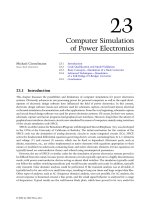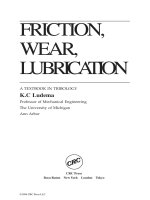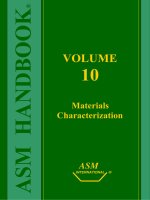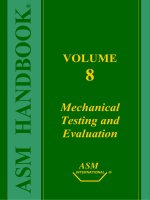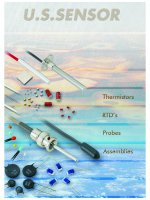Tài liệu Mechanical Engineering Handbook P1 doc
Bạn đang xem bản rút gọn của tài liệu. Xem và tải ngay bản đầy đủ của tài liệu tại đây (551.98 KB, 40 trang )
“Frontmatter”
Mechanical Engineering Handbook
Ed. Frank Kreith
Boca Raton: CRC Press LLC, 1999
c
1999byCRCPressLLC
Contents
______________________________
SECTION 1 Mechanics of Solids Bela I. Sandor
1.1 Introduction Bela I Sandor
1.2 Statics Bela I. Sandor
1.3 Dynamics Stephen M. Birn and Bela I. Sandor
1.4 Vibrations Bela I. Sandor
1.5 Mechanics of Materials Bela I. Sandor
1.6 Structural Integrity and Durability Bela I. Sandor
1.7 Comprehensive Example of Using Mechanics of Solids Methods
Richard C. Duveneck, David A. Jahnke, Christopher J. Watson, and Bela I. Sandor
SECTION 2 Engineering Thermodynamics Michael J. Moran
2.1 Fundamentals Michael J.Moran
2.2 Control Volume Applications Michael J.Moran
2.3 Property Relations and Data Michael J.Moran
2.4 Combustion Michael J.Moran
2.5 Exergy Analysis Michael J.Moran
2.6 Vapor and Gas Power Cycles Michael J.Moran
2.7 Guidelines for Improving Thermodynamic Effectiveness
Michael J.Moran
SECTION 3 Fluid Mechanics Frank Kreith
3.1 Fluid Statics Stanley A.Berger
3.2 Equations of Motion and Potential Flow Stanley A.Berger
3.3 Similitude: Dimensional Analysis and Data Correlation Suar W.Churchill
3.4 Hydraulics of Pipe Systems J.Paul Tullis
3.5 Open Channel Flow Frank M.White
3.6 External Incompressible Flow Alan T.McDonald
3.7 Compressible Flow Ajay Kumar
3.8 Multiphase Flow John C.Chen
3.9 Non-Newtonian Flow Thomas F.Irvine Jr. and Massimo Capobianchi
3.10 Tribology, Lubrication, and Bearing Design Francis E.Kennedy,
E.Richard Booser, and Donald F.Wilcock
3.11 Pumps and Fans Rober F.Boehm
3.12 Liquid Atomization and Spraying Rolf D.Reitz
3.13 Flow Measurement Alan T.McDonald and Sherif A.Sherif
3.14 Micro/Nanotribology Bharat Bhushan
SECTION 4 Heat and Mass Transfer Frank Kreith
4.1 Conduction Heat Transfer Rober F.Boehm
4.2 Convection Heat Transfer George D.Raithby, K.G.Terry Hollands,
and N.V.Suryanarayana
4.3 Radiation Michael F.Modest
4.4 Phase-Change Van P.Carey, John C.Chen and Noam Lior
c
1999byCRCPressLLC
4.5 Heat Exchangers Ramesh K.Shah and Kenneth J.Bell
4.6 Temperature and Heat Transfer Measurements Robert J.Moffat
4.7 Mass Transfer Anthony F.Mills
4.8 Applications Arthur E.Bergles, Anthony F.Mills, Larry W.Swanson,
and Vincent W.Antonetti
4.9 Non-Newtonian Fluids —Heat Transfer Thomas F.Irvine,Jr. and
Massimo Capobianchi
SECTION 5 Electrical Engineering Giorgio Rizzoni
5.1 Introduction Giorgio Rizzoni
5.2 Fundamentals of Electric Circuits Giorgio Rizzoni
5.3 Resistive Network Analysis Giorgio Rizzoni
5.4 AC Network Analysis Giorgio Rizzoni
5.5 AC Power Giorgio Rizzoni
5.6 Frequency Response,Filters,and Transient Analysis Giorgio Rizzoni
5.7 Electronics Giorgio Rizzoni
5.8 Power Electronics Giorgio Rizzoni
5.9 Operational Amplifiers Giorgio Rizzoni
5.10 Digital Circuits Giorgio Rizzoni
5.11 Measurements and Instrumentation Giorgio Rizzoni
5.12 Electromechanical Systems Giorgio Rizzoni
SECTION 6 Mechanical System Controls Jan F. Kreider
6.1 Human – Machine Interaction Thomas B. Sheridan
6.2 The Need for Control of Mechanical Systems Peter S. Curtiss
6.3 Control System Analysis Peter S. Curtiss
6.4 Control System Design and Application Peter S. Curtiss
6.5 Advanced Control Topics Peter S. Curtiss, Jan Kreider, Ronald M.Nelson,
and Shou-Heng Huang
SECTION 7 Energy Resources D. Yogi Goswami
7.1 Introduction D.Yogi Goswami
7.2 Types of Derived Energy D.Yogi Goswami
7.3 Fossil Fuels Robert Reuther, Richard Bajura, Larry Grayson, and
Philip C. Crouse
7.4 Biomass Energy Michael C.Reed, Lynn L.Wright, Ralph P.Overend,
and Carlton Wiles
7.5 Nuclear Resources James S. Tulenko
7.6 Solar Energy Resources D.Yogi Goswami
7.7 Wind Energy Resources Dale E.Berg
7.8 Geothermal Energy Joel L. Renner and Marshall J. Reed
SECTION 8 Energy Conversion D. Yogi Goswam
8.1 Steam Power Plant Lawrence Conway
8.2 Gas Turbines Steven I. Freedman
8.3 Internal Combustion Engines David E. Klett and Elsayed A.Adfify
8.4 Hydraulic Turbines Roger E.A. Arndt
8.5 Stirling Engines William B. Stine
8.6 Advanced Fossil Fuel Power Systems Anthony F. Armor
8.7 Energy Storage Chand K. Jotshi and D.Yogi Goswami
8.8 Nuclear Power Robert Pagano and James S. Tulenko
c
1999byCRCPressLLC
8.9 Nuclear Fusion Thomas E. Shannon
8.10 Solar Thermal Energy Conversion D.Yogi Goswami
8.11 Wind Energy Conversion Dale E. Berg
8.12 Energy Conversion of the Geothermal Resource Carl J. Bliem and
Gregory L. Mines
8.13 Direct Energy Conversion Kitt C. Reinhardt, D.Yogi Goswami,
Mysore L. Ramalingam , Jean-Pierre Fleurial, and William D. Jackson
8.14 Ocean Energy Technology Desikan Bharathan and Federica Zangrando
8.15 Combined Cycle Power Plants William W. Bathie
8.16 EMERGY Evaluation and Transformity Howard T.Odum
SECTION 9 Air Conditioning and Refrigeration Shan K. Wang
9.1 Introduction Shan K.Wang
9.2 Psychrometrics Shan K.Wang
9.3 Air Conditioning Processes and Cycles Shan K.Wang
9.4 Refrigerants and Refrigeration Cycles Shan K.Wang
9.5 Outdoor Design Conditions and Indoor Design Criteria Shan K.Wang
9.6 Load Calculations Shan K.Wang
9.7 Air Handling Units and Packaged Units Shan K.Wang
9.8 Refrigeration Components and Evaporative Coolers Shan K.Wang
'
9.9 Water Systems Shan K.Wang
9.10 Heating Systems Shan K.Wang
9.11 Refrigeration Systems Shan K.Wang
9.12 Thermal Storage Systems Shan K.Wang
9.13 Air Systems Shan K.Wang
9.14 Absorption Systems Shan K.Wang
9.15 Air Conditioning Systems and Selection Shan K.Wang
9.16 Desiccant Dehumidification and Air Conditioning Zalman Lavan
SECTION 10A Electronic Packaging
10A.1 Electronic Packaging Technologies Kevin D. Cluff and Michael G. Pecht
10A.2 Thermal Management in Electronic Packaging and Systems B.G. Sammakia and
K. Ramakrishna
10A.3 Mechanical Design and Reliability of Electronic Systems Fred Barez
10A.4 Electronic Manufacturing: Processes, Optimization, and Control Roop L. Mahajan
SECTION 10 Transportation Frank Kreith
10.1 Transportation Planning Michael D.Meyer
10.2 Design of Transportation Facilities John Leonard II and Michael D.Meyer
10.3 Operations and Environmental Impact Paul W.Shuldiner and Kenneth B.Black
10.4 Transportation Systems Paul Schonfeld
10.5 Alternative Fuels for Motor Vehicles Paul Norton
10.6 Electric Vehicles Frank Kreith
10.7 Intelligent Transportation Systems James B. Reed
SECTION 11 Engineering Design Leonard D. Albano and
Nam P. Suh
11.1 Introduction Nam P. Suh
11.2 Elements of the Design Process Nam P. Suh
11.3 Concept of Domains Nam P. Suh
11.4 The Axiomatic Approach to Design Nam P. Suh
c
1999byCRCPressLLC
11.5 Algorithmic Approaches to Design Leonard D. Albano
11.6 Strategies for Product Design Michael Pecht
11.7 Design of Manufacturing Systems and Processes Leonard D. Albano
11.8 Precision Machine Design Alexander Slocum
11.9 Robotics Leonard D. Albano
11.10 Computer-Based Tools for Design Optimization Mark Jakiela,
Kemper Lewis, Farrokh Mistree, and J.R. Jagannatha Rao
SECTION 12 Material Richard L. Lehman and Malcolm G. McLaren
12.1 Metals Victor A. Greenhut
12.2 Polymers James D. Idol and Richard L. Lehman
12.3 Adhesives Richard L. Lehman
12.4 Wood Daniel J. Strange
12.5 Portland Cement Concrete Steven H. Kosmatka
12.6 Composites Victor A. Greenhut
12.7 Ceramics and Glass Richard L.Lehman, Daniel J.Strange, and
William F. Fischer III
SECTION 13 Modern Manufacturing Jay Lee and
Robert E. Schafrik
13.1 Introduction Jay Lee and Robert E. Schafrik
13.2 Unit Manufacturing and Assembly Processes Robert E. Schafrik
13.3 Essential Elements in Manufacturing Processes and Equipment
John Fildes, Yoram Koren, M. Tomizuka, Kam Lau, and Tai-Ran Hsu
13.4 Modern Design and Analysis Tools for Manufacturing
David C .Anderson,Tien-Chien Chang,Hank Grant,Tien-I. Liu,
J.M.A. Tanchoco,Andrew C. Lee,and Su-Hsia Yang
13.5 Rapid Prototyping Takeo Nakagawa
13.6 Underlying Paradigms in Manufacturing Systems and Enterprise
for the 21st Century H.E.Cook, James J.Solberg, and Chris Wang
SECTION 14 Robotics Frank L. Lewis
14.1 Introduction Frank L.Lewis
14.2 Commercial Robot Manipulators John M.Fitzgerald
14.3 Robot Configurations Ian D.Walker
14.4 End Effectors and Tooling Mark R.Cutkosky and Peter McCormick
14.5 Sensors and Actuators Kok-Meng Lee
14.6 Robot Programming Languages Ron Bailey
14.7 Robot Dynamics and Control Frank L. Lewis
14.8 Planning and Intelligent Control Chen Zhou
14.9 Design of Robotic Systems Kok-Meng Lee
14.10 Robot Manufacturing Applications John W. Priest and G.T. Stevens, Jr.
14.11 Industrial Material Handling and Process Applications of Robots
John M. Fitzgerald
14.12 Moblie, Flexible-Link, and Parallel-Link Robots Kai Liu
SECTION 15 Computer-Aided Engineering Kyran D. Mish
15.1 Introduction Kyran D. Mish
15.2 Computer Programming and Computer Architecture
Kyran D. Mish
15.3 Computational Mechanics Kyran D. Mish
c
1999byCRCPressLLC
15.4 Computer Intelligence Kyran D. Mish
15.5 Computer-Aided Design (CAD) Joseph Mello
SECTION 16 Environmental Engineering Jan F. Kreider
16.1 Introduction Ari Rabl and Jan F. Kreider
16.2 Benchmarks and Reference Conditions Ari Rabl, Nevis Cook,
Ronald H. Hewitt Cohen, and Tissa Illangasekare
'
16.3 Sources of Pollution and Regulations Jan F.Kreider, Nevis Cook,
Tissa Illangasekare, and Ronald H. Hewitt Cohen
16.4 Regulations and Emission Standards Nevis Cook and Ronald H Hewitt Cohen
16.5 Mitigation of Water and Air Pollution Jan F. Kreider, Nevis Cook,
and Ronald H .Hewitt Cohen
16.6 Environmental Modeling Paolo Zannetti, Ronald H. Hewitt Cohen,
Nevis Cook, Ari Rabl, and Peter S. Curtiss
16.7 Global Climate Change Frank Kreith
SECTION 17 Engineering Economics and Project Management
Chan S. Park and Donald D. Tippett
17.1 Engineering Economic Decisions Chan S. Park
17.2 Establishing Economic Equivalence Chan S. Park
17.3 Measures of Project Worth Chan S. Park
17.4 Cash Flow Projections Chan S. Park
17.5 Sensitivity and Risk Analysis Chan S. Park
17.6 Design Economics Chan S. Park
17.7 Project Management Donald D. Tippett
SECTION 18 Communications and Information Systems
Lloyd W. Taylor
18.1 Introduction Lloyd W. Taylor
18.2 Network Components and Systems Lloyd W. Taylor and
Daniel F. DiFonzo
18.3 Communications and Information Theory A. Britton Cooper III
18.4 Applications Lloyd W. Taylor, Dhammika Kurumbalapitiya, and
S.Ratnajeevan H.Hoole
SECTION 19 Mathematics William F. Ames and George Cain
19.1 Tables William F.Ames
19.2 Linear Algebra and Matrices George Cain
19.3 Vector Algebra and Calculus George Cain
19.4 Difference Equations William F. Ames
19.5 Differential Equations William F. Ames
19.6 Integral Equations William F. Ames
19.7 Approximation Methods William F. Ames
19.8 Integral Transforms William F. Ames
19.9 Calculus of Variations Approximation William F. Ames
19.10 Optimization Methods George Cain
19.11 Engineering and Statistics Y.L. Tong
19.12 Numerical Methods William F. Ames
19.13 Experimental Uncertainty Analysis W.G. Steele and H.W. Coleman
19.14 Chaos R.L. Kautz
19.15 Fuzzy Sets and Fuzzy Logic Dan M. Frangopol
c
1999byCRCPressLLC
SECTION 20 Patent Law and Miscellaneous Topics Frank Kreith
20.1 Patents and Other Intellectual Property Thomas H. Young
20.2 Product Liability and Safety George A. Peters
20.3 Bioengineering Jeff R. Crandall, Gregory W. Hall, and
Walter D. Pilkey
20.4 Mechanical Engineering Codes and Standard Michael Merker
20.5 Optics Roland Winston and Walter T. Welford
20.6 Water Desalination Noam Lior
20.7 Noise Control Malcolm J. Crocker
20.8 Lighting Technology Barbara Atkinson, Andrea Denver, James E. McMahon,
Leslie Shown, Robert Clear, and Craig B Smith
20.9 New Product Development Philip R. Teakle and Duncan B. Gilmore
APPENDICES Paul Norton
A. Properties of Gases and Vapors
B. Properties of Liquids
C. Properties of Solids
D. SI Units
E. Miscellaneous
c
1999byCRCPressLLC
Sandor, B.I.; Roloff, R; et. al. “Mechanics of Solids”
Mechanical Engineering Handbook
Ed. Frank Kreith
Boca Raton: CRC Press LLC, 1999
c
1999byCRCPressLLC
1
-1
© 1999 by CRC Press LLC
Mechanics of Solids
1.1 Introduction......................................................................1-1
1.2 Statics...............................................................................1-3
Vectors. Equilibrium of Particles. Free-body Diagrams • Forces
on Rigid Bodies • Equilibrium of Rigid Bodies • Forces and
Moments in Beams • Simple Structures and Machines •
Distributed Forces • Friction • Work and Potential Energy •
Moments of Inertia
1.3 Dynamics........................................................................1-31
Kinematics of Particles • Kinetics of Particles • Kinetics of
Systems of Particles • Kinematics of Rigid Bodies • Kinetics
of Rigid Bodies in Plane Motion • Energy and Momentum
Methods for Rigid Bodies in Plane Motion • Kinetics of Rigid
Bodies in Three Dimensions
1.4 Vibrations.......................................................................1-57
Undamped Free and Forced Vibrations • Damped Free and
Forced Vibrations • Vibration Control • Random Vibrations.
Shock Excitations • Multiple-Degree-of-Freedom Systems.
Modal Analysis • Vibration-Measuring Instruments
1.5 Mechanics of Materials..................................................1-67
Stress • Strain • Mechanical Behaviors and Properties of
Materials • Uniaxial Elastic Deformations • Stresses in Beams
• Deflections of Beams • Torsion • Statically Indeterminate
Members • Buckling • Impact Loading • Combined Stresses •
Pressure Vessels • Experimental Stress Analysis and
Mechanical Testing
1.6 Structural Integrity and Durability...............................1-104
Finite Element Analysis. Stress Concentrations • Fracture
Mechanics • Creep and Stress Relaxation • Fatigue
1.7 Comprehensive Example of Using Mechanics of Solids
Methods........................................................................1-125
The Project • Concepts and Methods
1.1Introduction
Bela I. Sandor
Engineers use the concepts and methods of mechanics of solids in designing and evaluating tools,
machines, and structures, ranging from wrenches to cars to spacecraft. The required educational back-
ground for these includes courses in statics, dynamics, mechanics of materials, and related subjects. For
example, dynamics of rigid bodies is needed in generalizing the spectrum of service loads on a car,
which is essential in defining the vehicle’s deformations and long-term durability. In regard to structural
Bela I. Sandor
University of Wisconsin-Madison
Ryan Roloff
Allied Signal Aerospace
Stephen M. Birn
Allied Signal Aerospace
Maan H. Jawad
Nooter Consulting Services
Michael L. Brown
A.O. Smith Corp.
1
-2
Section 1
integrity and durability, the designer should think not only about preventing the catastrophic failures of
products, but also of customer satisfaction. For example, a car with gradually loosening bolts (which is
difficult to prevent in a corrosive and thermal and mechanical cyclic loading environment) is a poor
product because of safety, vibration, and noise problems. There are sophisticated methods to assure a
product’s performance and reliability, as exemplified in Figure 1.1.1. A similar but even more realistic
test setup is shown in Color Plate 1.
*
It is common experience among engineers that they have to review some old knowledge or learn
something new, but what is needed at the moment is not at their fingertips. This chapter may help the
reader in such a situation. Within the constraints of a single book on mechanical engineering, it provides
overviews of topics with modern perspectives, illustrations of typical applications, modeling to solve
problems quantitatively with realistic simplifications, equations and procedures, useful hints and remind-
ers of common errors, trends of relevant material and mechanical system behaviors, and references to
additional information.
The chapter is like an emergency toolbox. It includes a coherent assortment of basic tools, such as
vector expressions useful for calculating bending stresses caused by a three-dimensional force system
on a shaft, and sophisticated methods, such as life prediction of components using fracture mechanics
and modern measurement techniques. In many cases much more information should be considered than
is covered in this chapter.
*
Color Plates 1 to 16 follow page 1-131.
FIGURE 1.1.1
Artist’s concept of a moving stainless steel roadway to drive the suspension system through a
spinning, articulated wheel, simulating three-dimensional motions and forces. (MTS Systems Corp., Minneapolis,
MN. With permission.) Notes: Flat-Trac
®
Roadway Simulator, R&D100 Award-winning system in 1993. See also
Color Plate 1.
*
Mechanics of Solids
1
-3
1.2Statics
Bela I. Sandor
Vectors. Equilibrium of Particles. Free-Body Diagrams
Two kinds of quantities are used in engineering mechanics. A scalar quantity has only magnitude (mass,
time, temperature, …). A vector quantity has magnitude and direction (force, velocity, ...). Vectors are
represented here by arrows and bold-face symbols, and are used in analysis according to universally
applicable rules that facilitate calculations in a variety of problems. The vector methods are indispensable
in three-dimensional mechanics analyses, but in simple cases equivalent scalar calculations are sufficient.
Vector Components and Resultants. Parallelogram Law
A given vector
F
may be replaced by two or three other vectors that have the same net effect and
representation. This is illustrated for the chosen directions
m
and
n
for the components of
F
in two
dimensions (Figure 1.2.1). Conversely, two concurrent vectors
F
and
P
of the same units may be
combined to get a resultant
R
(Figure 1.2.2).
Any set of components of a vector
F
must satisfy the
parallelogram law
. According to Figure 1.2.1,
the law of sines and law of cosines may be useful.
(1.2.1)
Any number of concurrent vectors may be summed, mathematically or graphically, and in any order,
using the above concepts as illustrated in Figure 1.2.3.
FIGURE 1.2.1
Addition of concurrent vectors
F
and
P
.
FIGURE 1.2.2
Addition of concurrent, coplanar
vectors
A
,
B
, and
C
.
FIGURE 1.2.3
Addition of concurrent, coplanar vectors
A
,
B
, and
C
.
FF
F
FF
nm
nm
sin sin
sin
cos
αβ
αβ
αβ
==
°− +
()
[]
=+− °−+
()
[]
180
2 180
222
FFF
nm
1
-4
Section 1
Unit Vectors
Mathematical manipulations of vectors are greatly facilitated by the use of unit vectors. A unit vector
n
has a magnitude of unity and a defined direction. The most useful of these are the unit coordinate
vectors
i
,
j
, and
k
as shown in Figure 1.2.4.
The three-dimensional components and associated quantities of a vector
F
are shown in Figure 1.2.5.
The unit vector
n
is collinear with
F
.
The vector
F
is written in terms of its scalar components and the unit coordinate vectors,
(1.2.2)
where
The unit vector notation is convenient for the summation of concurrent vectors in terms of scalar or
vector components:
Scalar components of the resultant
R
:
(1.2.3)
FIGURE 1.2.4
Unit vectors in Cartesian coordinates (the same
i
,
j
,
and
k
set applies in a parallel
x
′
y
′
z
′
system of axes).
FIGURE 1.2.5
Three-dimensional components of a vector
F
.
Fijkn=++=FFF
xyz
F
FFF
xxyyzz
===
=++
FFF
FFFF
xyz
cos cos cosθθθ
222
n
nnn
xyz
xxyyzz
nn===
++=
cos cos cosθθθ
222
1
n
n
n
x
x
y
y
z
z
FFFF
===
1
RFRFRF
xxyyzz
===
∑∑∑
Mechanics of Solids
1
-5
Vector components:
(1.2.4)
Vector Determination from Scalar Information
A force, for example, may be given in terms of its magnitude
F
, its sense of direction, and its line of
action. Such a force can be expressed in vector form using the coordinates of any two points on its line
of action. The vector sought is
The method is to find
n
on the line of points
A
(
x
1
,
y
1
,
z
1
) and
B
(
x
2
,
y
2
,
z
2
):
where
d
x
=
x
2
–
x
1
,
d
y
=
y
2
–
y
1
,
d
z
=
z
2
–
z
1
.
Scalar Product of Two Vectors. Angles and Projections of Vectors
The scalar product, or dot product, of two concurrent vectors
A
and
B
is defined by
(1.2.5)
where
A
and
B
are the magnitudes of the vectors and
φ
is the angle between them. Some useful expressions
are
The projection
F
′
of a vector
F
on an arbitrary line of interest is determined by placing a unit vector
n on that line of interest, so that
Equilibrium of a Particle
A particle is in equilibrium when the resultant of all forces acting on it is zero. In such cases the
algebraic summation of rectangular scalar components of forces is valid and convenient:
(1.2.6)
Free-Body Diagrams
Unknown forces may be determined readily if a body is in equilibrium and can be modeled as a particle.
The method involves free-body diagrams, which are simple representations of the actual bodies. The
appropriate model is imagined to be isolated from all other bodies, with the significant effects of other
bodies shown as force vectors on the free-body diagram.
RFiRFjRFk
xxxyyyzzz
FFF== == ==
∑∑ ∑∑ ∑∑
Fijkn=++=FFF
xyz
F
n
ijk
==
++
++
vector A to B
distance A to B
d
ddd
xyz
xyz
dd
222
AB⋅=ABcosφ
ABBA⋅=⋅= + +
=
++
AB AB AB
AB AB AB
AB
xx yy zz
xx yy zz
φ arccos
′
=⋅= + +FFnFnFnFn
xx yy zz
FFF
xyz
∑∑∑
===000
1-6 Section 1
Example 1
A mast has three guy wires. The initial tension in each wire is planned to be 200 lb. Determine whether
this is feasible to hold the mast vertical (Figure 1.2.6).
Solution.
The three tensions of known magnitude (200 lb) must be written as vectors.
The resultant of the three tensions is
There is a horizontal resultant of 31.9 lb at A, so the mast would not remain vertical.
Forces on Rigid Bodies
All solid materials deform when forces are applied to them, but often it is reasonable to model components
and structures as rigid bodies, at least in the early part of the analysis. The forces on a rigid body are
generally not concurrent at the center of mass of the body, which cannot be modeled as a particle if the
force system tends to cause a rotation of the body.
FIGURE 1.2.6A mast with guy wires.
RTTT=++
AB AC AD
Tn
ijk
ijk i j k
AB AB
AB A B
d
d
=
()( )
==
++
()
=
++
−−+
()
=− − +
tension unit vector to lb lb
lb ft
ft
lb lb lb
200 200
200
5104
5 10 4 842 1684 674
222
xyz
dd
...
Tijkijk
AC
=−+
()
=++
200
1187
5 10 4 842 1684 674
lb
ft
ft lb lb lb
.
...
Tijkjk
AD
=−+
()
=− −
200
1166
0 10 6 1715 1029
lb
ft
ft lb lb
.
..
Rijk i j
kij k
=++=−++
()
+− − −
()
++−
()
=−+
∑∑∑
FFF
xyz
842842 0 168416841715
6746741029 0 508 319
.. ...
... .
lb lb
lb lb lb lb
Mechanics of Solids 1-7
Moment of a Force
The turning effect of a force on a body is called the moment of the force, or torque. The moment M
A
of a force F about a point A is defined as a scalar quantity
(1.2.7)
where d (the moment arm or lever arm) is the nearest distance from A to the line of action of F. This
nearest distance may be difficult to determine in a three-dimensional scalar analysis; a vector method
is needed in that case.
Equivalent Forces
Sometimes the equivalence of two forces must be established for simplifying the solution of a problem.
The necessary and sufficient conditions for the equivalence of forces F and F
′
are that they have the
same magnitude, direction, line of action, and moment on a given rigid body in static equilibrium. Thus,
For example, the ball joint A in Figure 1.2.7 experiences the same moment whether the vertical force
is pushing or pulling downward on the yoke pin.
Vector Product of Two Vectors
A powerful method of vector mechanics is available for solving complex problems, such as the moment
of a force in three dimensions. The vector product (or cross product) of two concurrent vectors A and
B is defined as the vector V = A × B with the following properties:
1.V is perpendicular to the plane of vectors A and B.
2.The sense of V is given by the right-hand rule (Figure 1.2.8).
3.The magnitude of V is V = AB sinθ, where θ is the angle between A and B.
4.A × B ≠ B × A, but A × B = –(B × A).
5.For three vectors, A × (B + C) = A × B + A × C.
FIGURE 1.2.7Schematic of testing a ball joint of a car.
FIGURE 1.2.8Right-hand rule for vector products.
MFd
A
=
FF=
′
=
′
and MM
AA
1-8 Section 1
The vector product is calculated using a determinant,
(1.2.8)
Moment of a Force about a Point
The vector product is very useful in determining the moment of a force F about an arbitrary point O.
The vector definition of moment is
(1.2.9)
where r is the position vector from point O to any point on the line of action of F. A double arrow is
often used to denote a moment vector in graphics.
The moment M
O
may have three scalar components, M
x
, M
y
, M
z
, which represent the turning effect
of the force F about the corresponding coordinate axes. In other words, a single force has only one
moment about a given point, but this moment may have up to three components with respect to a
coordinate system,
Triple Products of Three Vectors
Two kinds of products of three vectors are used in engineering mechanics. The mixed triple product (or
scalar product) is used in calculating moments. It is the dot product of vector A with the vector product
of vectors B and C,
(1.2.10)
The vector triple product (A × B) × C = V × C is easily calculated (for use in dynamics), but note that
Moment of a Force about a Line
It is common that a body rotates about an axis. In that case the moment M
ᐉ
of a force F about the axis,
say line ᐉ, is usefully expressed as
(1.2.11)
where n is a unit vector along the line ᐉ, and r is a position vector from point O on ᐉ to a point on the
line of action of F. Note that M
ᐉ
is the projection of M
O
on line ᐉ.
V
ijk
ijkkji==++−−−AAA
BBB
AB AB AB AB AB AB
xyz
xyz
yz zx xy yx xz zy
MrF
O
=×
Mijk
Ox y z
MMM=++
ABC⋅×
()
==−
()
+−
()
+−
()
AAA
BBB
CCC
ABC BC ABC BC ABC BC
xyz
xyz
xyz
xyz zy yzx xz zxy yx
AB CA BC×
()
×≠× ×
()
MnM nrF
l
=⋅ =⋅ ×
()
=
O
xyz
xyz
xyz
nnn
rrr
FFF

